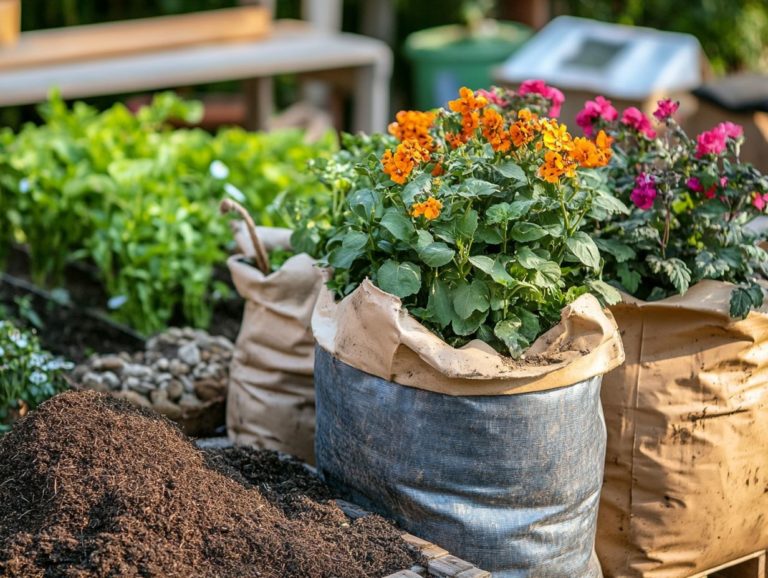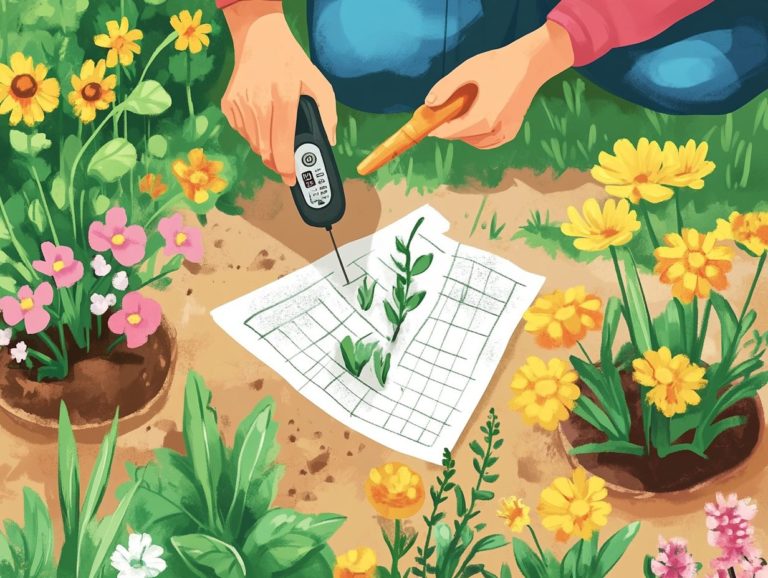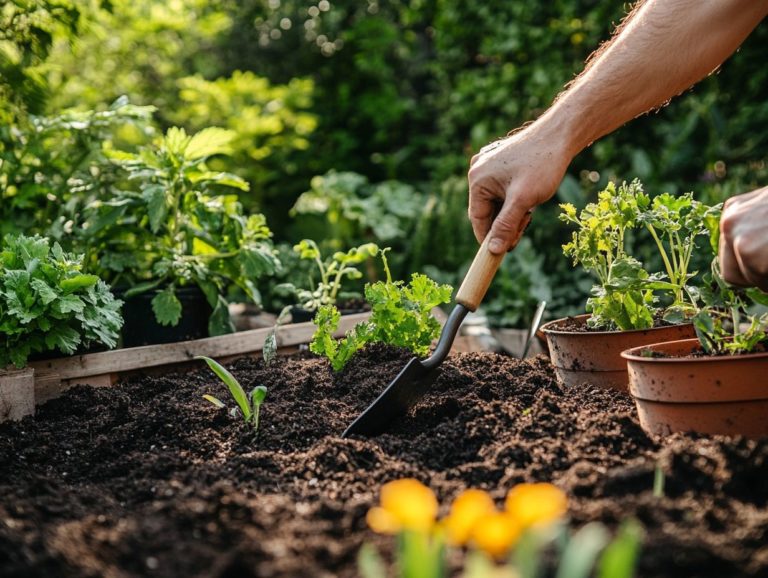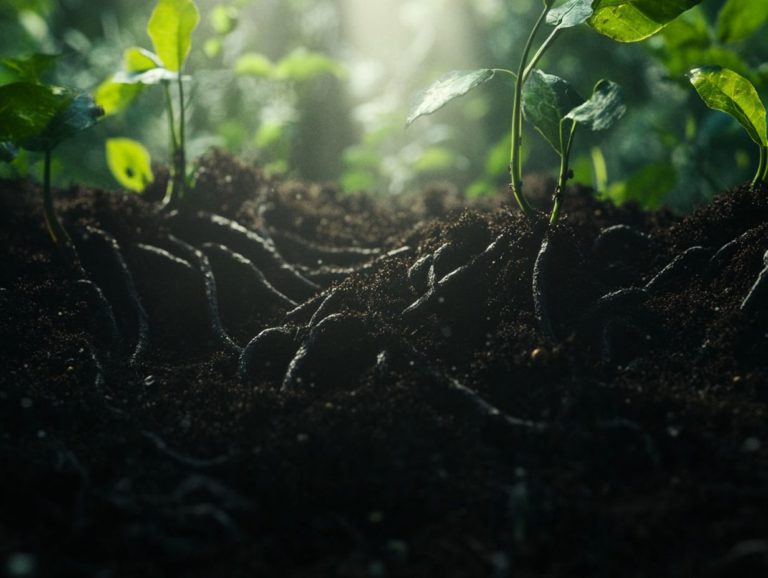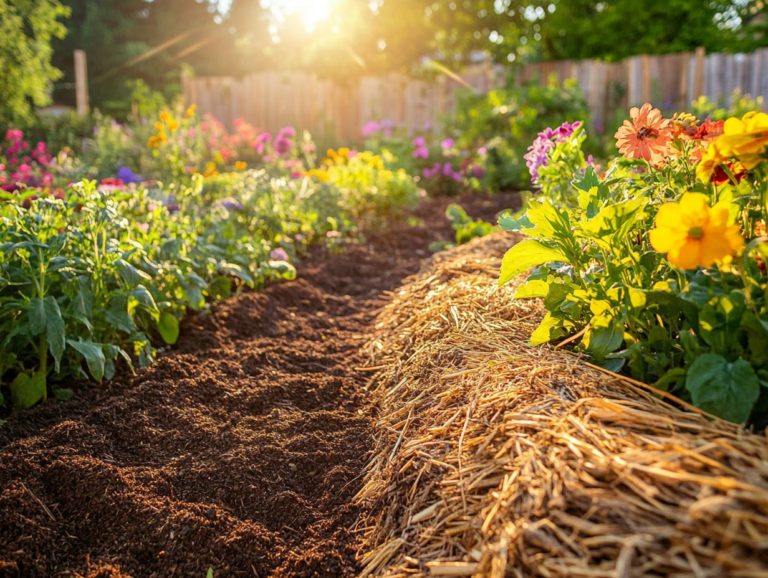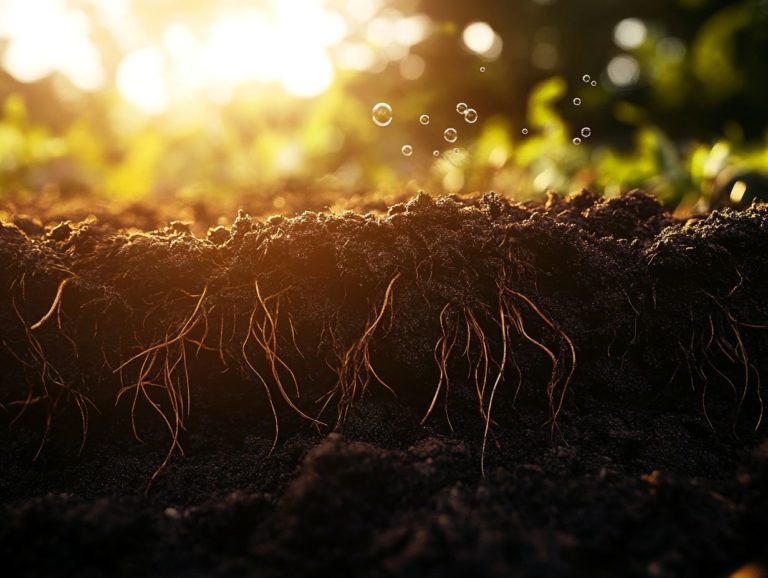5 Strategies to Prevent Soil Erosion
Soil erosion stands as a significant environmental challenge, imperiling not only our land but also our ecosystems and food security.
As you navigate the intricacies of preserving our planet, grasping effective ways to combat this issue becomes paramount.
Let’s explore five exciting strategies to prevent soil erosion, ranging from planting trees and shrubs to embracing sustainable farming methods.
Each of these approaches not only aids in safeguarding our soil but also contributes to the overall health of our environment.
Engage with us as we unpack these essential techniques and reveal the crucial role you can play in protecting our precious soil.
Contents
- Key Takeaways:
- 1. Plant Trees and Shrubs
- 2. Use Mulch to Cover Bare Soil
- 3. Create Terraces or Contour Plowing
- 4. Implement Water Management Techniques
- 5. Practice Sustainable Farming Methods
- What Is Soil Erosion and Why Is It a Problem?
- What Are the Different Types of Soil Erosion?
- How Can Planting Trees and Shrubs Help Prevent Soil Erosion?
- What Are the Benefits of Using Mulch to Protect Soil?
- How Can Terraces and Contour Plowing Help Prevent Soil Erosion?
- What Are Some Water Management Techniques That Can Help Prevent Soil Erosion?
- Discover Effective Sustainable Farming to Combat Soil Erosion
- How Can Individuals Make a Difference in Preventing Soil Erosion?
- What Are Some Common Causes of Soil Erosion?
- What Are the Long-Term Effects of Soil Erosion?
- What Are Some Government Policies and Programs in Place to Address Soil Erosion?
- Frequently Asked Questions
- Want to know 5 effective ways to stop soil erosion?
- How does conservation tillage help prevent soil erosion?
- Why are cover crops effective in preventing soil erosion and promoting soil health?
- What role do terraces and retaining walls play in preventing soil erosion?
- How can windbreaks and vegetation cover help prevent soil erosion?
- Why are buffer strips and riparian buffers important in preventing soil erosion?
Key Takeaways:
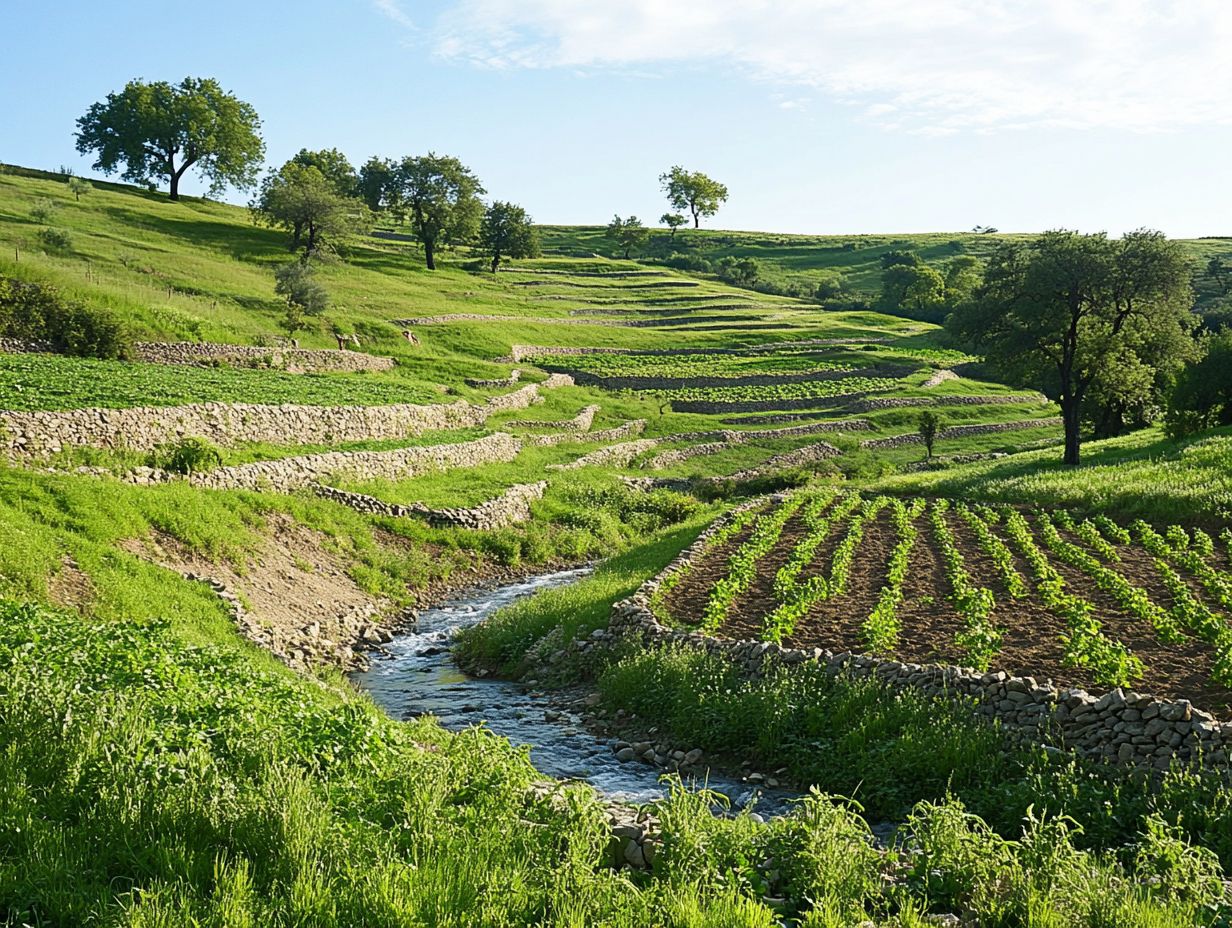
- Planting trees and shrubs can help prevent soil erosion by stabilizing the soil with their roots and providing coverage from wind and rain.
- Using mulch to cover bare soil retains moisture, reduces runoff, and protects the soil from erosion caused by wind and water.
- Creating terraces or using contour plowing slows down water flow and reduces the impact of rain on the soil.
1. Plant Trees and Shrubs
Planting trees and shrubs is key to preventing soil erosion. Their deep roots stabilize the soil and improve our local environment.
These trees and shrubs don t just look nice; they help clean water and boost soil fertility, creating a healthier ecosystem.
They maintain soil structure by binding the earth together, which reduces runoff and nutrient loss.
For example, native oak trees provide food and shelter for birds and insects, while resilient species like mesquite stabilize sandy soils, showing their importance in sustainable farming.
2. Use Mulch to Cover Bare Soil
Using mulch to cover bare soil is an effective strategy to prevent soil erosion. Mulch acts as a shield against the impacts of wind and water while promoting the process of nutrients moving through the environment.
You have a variety of mulch options at your disposal. Organic choices like wood chips and straw enrich the soil, while inorganic options, such as rubber or stone, provide different benefits.
Each type of mulch has its unique advantages:
- Organic mulch improves soil structure and fosters beneficial microbial activity as it decomposes.
- Inorganic mulch helps stabilize temperatures and retains moisture over longer periods.
Using mulch reduces evaporation and enhances moisture retention, creating an ideal environment for plant growth. It also improves water quality by allowing water to penetrate the soil more easily and reducing stormwater runoff.
3. Create Terraces or Contour Plowing
Creating terraces or implementing contour plowing are effective erosion control techniques that help manage rainfall impact. These methods reduce soil runoff and enhance water retention, promoting sustainable agricultural practices.
By shaping the land into step-like terraces or plowing along the contours, you effectively slow down water movement. This allows water to seep into the soil instead of washing it away.
Both techniques boost soil fertility by retaining nutrients and enhancing crop productivity, leading to resilient farming systems that yield sustainable results.
4. Implement Water Management Techniques
Implementing effective water management techniques, such as rain gardens and efficient irrigation systems, is essential for enhancing soil health. These practices manage excess rainwater that flows over land and can cause erosion, as well as prevent soil erosion across various landscapes.
These techniques encourage deeper root growth, helping retain soil moisture. Practices like contour farming and the use of swales are key in redirecting water to where it s needed most, reducing runoff and soil degradation.
Integrating vegetation management is vital; planting cover crops and perennial vegetation offers ground cover that protects the soil from erosion. This enhances nutrient cycling and supports biodiversity.
Collectively, these approaches foster a more resilient agricultural ecosystem, ensuring sustainability for generations to come.
5. Practice Sustainable Farming Methods
Embracing sustainable farming methods like crop rotation and green manure can significantly reduce soil erosion. These methods enhance soil fertility and tackle the environmental challenges posed by nutrient loss.
These techniques anchor the soil and improve its overall structure and health. This makes it more resilient against heavy rains and winds.
For example, crop rotation brings in diverse root systems that enhance soil aeration and moisture retention, nurturing a more vibrant ecosystem. Cover crops contribute organic matter, playing a crucial role in nutrient cycling, while green manure replenishes essential nutrients through decomposition.
Together, these practices create a balanced ecosystem that prevents crop failure and promotes biodiversity, ensuring long-term agricultural productivity and ecological stability.
What Is Soil Erosion and Why Is It a Problem?
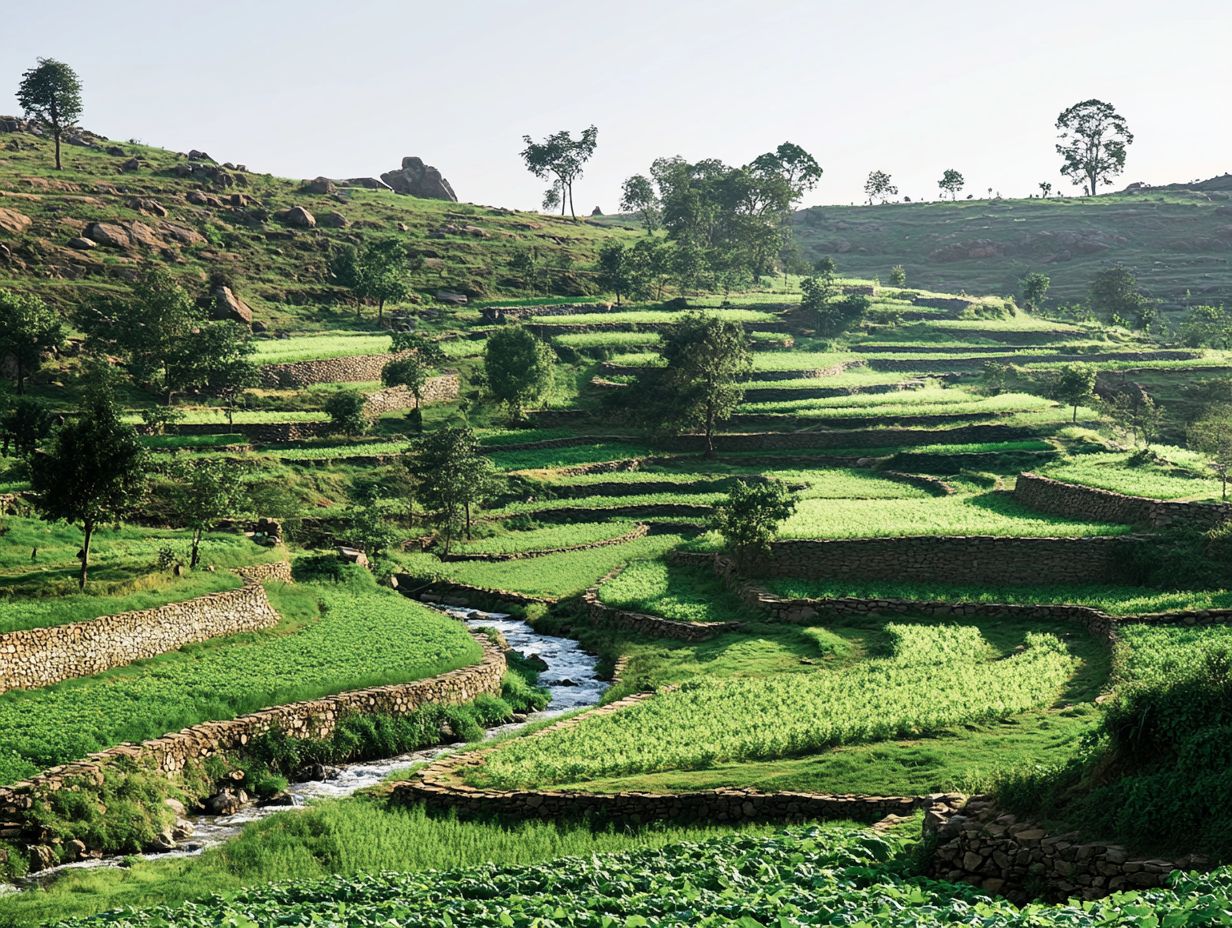
Soil erosion is the process where the top layer of soil, vital for agriculture and natural ecosystems, gets stripped away. This poses significant environmental threats, including reduced water quality and diminished soil fertility.
Negative impacts on aquatic life become even more pronounced with climate change and unsustainable farming practices. This critical process unfolds through various mechanisms, such as water runoff, wind, and human activities like deforestation and overgrazing.
The consequences are extensive; as fertile soil is whisked away, agricultural productivity takes a hit, leading to lower crop yields per acre. This reduction affects food supply chains and exacerbates poverty in farming-dependent communities.
When soil erosion occurs, sediments can clog rivers and streams, degrading water quality and disrupting the fragile balance of freshwater ecosystems. As a result, both land and water bodies suffer, highlighting an urgent need for sustainable practices to tackle this escalating challenge.
What Are the Different Types of Soil Erosion?
There are several types of soil erosion to be aware of, including water erosion and wind erosion. Each has unique causes and impacts on soil compaction and overall land degradation, particularly influenced by the intensity of rainfall.
Take water erosion, for example. It tends to worsen with heavy rainfall, leading to significant nutrient loss that can severely affect agricultural productivity. This type of erosion typically manifests in three forms: sheet erosion, rill erosion, and gully erosion, each differing in severity and scale.
On the flip side, wind erosion primarily occurs in drier climates or exposed landscapes, driven by strong gusts that lift loose particles and contribute to the deterioration of topsoil.
To effectively combat these erosive forces, you can adopt strategies like:
- planting cover crops
- building terraces
- employing windbreaks
These measures can significantly reduce erosion rates, safeguarding soil fertility and ensuring sustainability for future generations. Let s act now to protect our environment and secure food for the future!
How Can Planting Trees and Shrubs Help Prevent Soil Erosion?
Planting trees and shrubs is essential! They play a crucial role in preventing soil erosion by establishing a protective plant cover. Their deep roots enhance soil health and foster biodiversity within the ecosystem.
The intricate root structures of these plants weave through the soil, forming a natural barrier that binds soil particles together. This process effectively reduces the risk of erosion during heavy rainfall.
The canopy cover provided by mature trees serves as a shield against the impact of raindrops. This significantly minimizes surface runoff.
Take, for example, the successful reforestation projects in Ethiopia. The strategic planting of Acacia trees has not only stabilized the soil but also led to a remarkable increase in local biodiversity. These practices have resulted in notable improvements in soil fertility, highlighting the profound connection between vegetation and the soil’s ability to retain nutrients and moisture.
What Are the Benefits of Using Mulch to Protect Soil?
Using mulch to protect your soil comes with a wealth of benefits! These include enhanced erosion control, improved water quality, and recycling nutrients, all of which contribute to healthier agricultural practices.
This technique shields the soil from the harsh impacts of wind and water erosion while retaining moisture. This ensures your plants receive the hydration they need during dry spells.
You can choose from various mulching materials:
- Wood chips
- Straw
- Grass clippings
Each type brings its own set of advantages. Take organic mulches like straw, for example; they break down over time, enriching the soil with organic matter and promoting a thriving ecosystem of tiny organisms that help plants grow.
Mulching also keeps pesky weeds at bay. This allows your plants to access more nutrients and sunlight, ultimately boosting their health and yield.
By maintaining a stable soil temperature, mulch creates the perfect environment for root development, leading to stronger, more resilient plants.
How Can Terraces and Contour Plowing Help Prevent Soil Erosion?
Terraces and contour plowing are exceptionally effective methods to combat soil erosion! They expertly manage rainfall impact, minimize runoff, and promote sustainable agricultural practices across sloped terrains.
By transforming steep land into a series of step-like platforms, terraces decelerate water movement and enhance moisture retention. This grants crops better access to hydration.
Contour plowing is another method. It involves tilling across the slope to create furrows that naturally collect and retain water during rainfall.
Both techniques are meticulously designed, with layouts tailored to the specific landscape and soil type. This ensures maximum effectiveness. When implemented together, these practices significantly elevate soil fertility by reducing nutrient loss and fostering a healthier ecosystem. This ultimately paves the way for more productive and resilient agricultural systems.
What Are Some Water Management Techniques That Can Help Prevent Soil Erosion?
Several water management techniques are essential for preventing soil erosion! These include the creation of rain gardens and the establishment of efficient irrigation systems. Additionally, incorporating techniques for sustainable soil management can further enhance soil health and make a significant impact.
Incorporating practices like contour farming and cover cropping will further strengthen your fields against erosion. For more insights, explore best practices for soil erosion control. These methods improve water absorption and promote nutrient retention, ensuring your crops thrive.
Implementing terraces on steep slopes reduces runoff and makes it easier for you to farm in areas that might otherwise pose challenges.
Integrating these water management strategies not only conserves your soil but also aligns with broader sustainable agriculture goals. By increasing biodiversity and promoting ecological balance within your farming ecosystem, you re not just cultivating crops; you re fostering a healthier environment.
This holistic approach encourages you to embrace land stewardship principles. Start implementing these techniques today to enhance your agricultural practices and benefit the surrounding landscape!
Discover Effective Sustainable Farming to Combat Soil Erosion
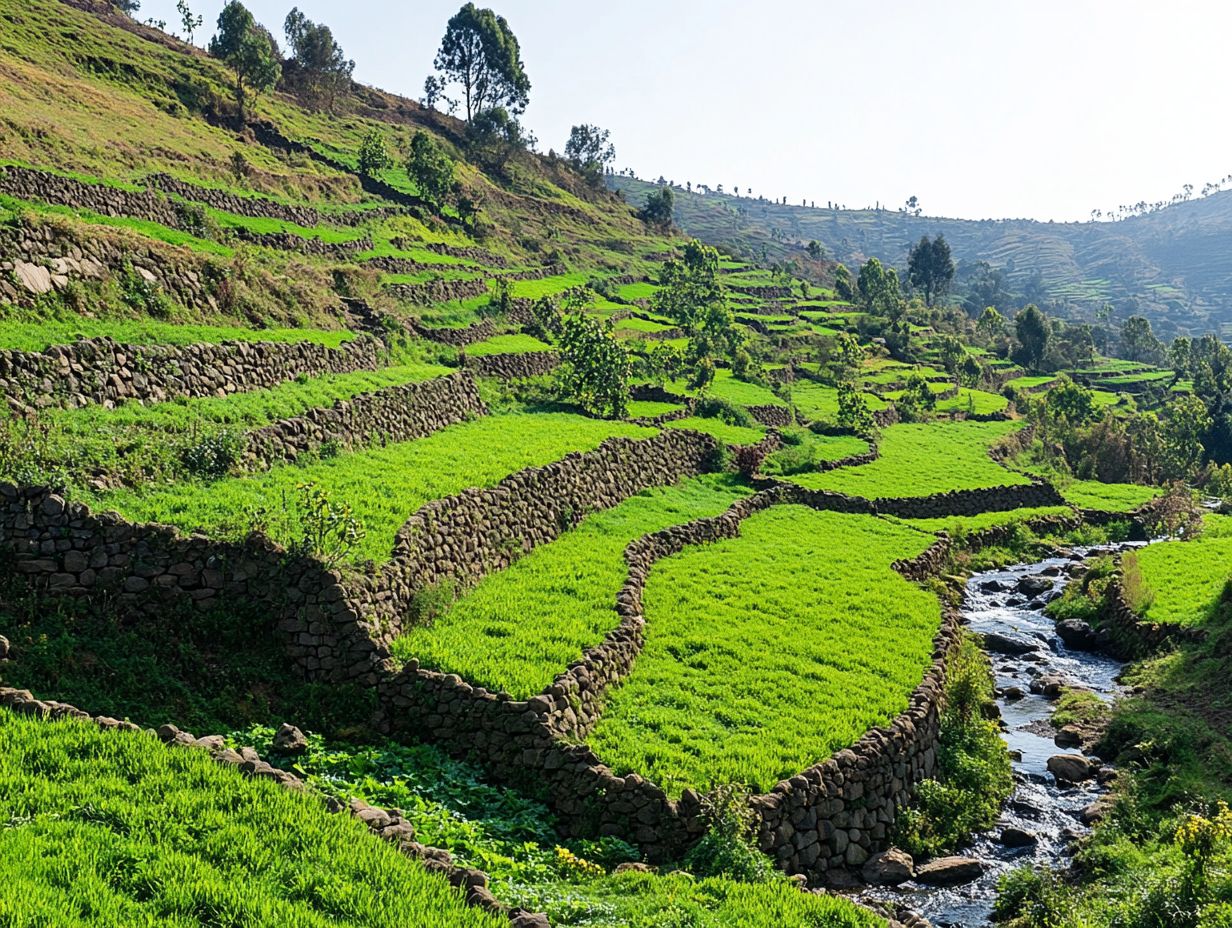
Sustainable farming methods, like crop rotation, cover crops, and green manure, are essential for preventing soil erosion while enhancing fertility and promoting ecological balance.
These practices do much more than boost immediate crop yields; they foster a healthier ecosystem for future generations. By implementing crop rotation, you can minimize pest buildup and increase biodiversity. Research shows that diverse crop systems can reduce erosion rates by as much as 30% compared to monoculture practices.
Cover crops also serve as a valuable tool. They improve soil structure and organic matter content, enhancing water retention and nutrient cycling. Using green manure plants grown to improve soil health can elevate soil nitrogen levels by 20-30%, further enriching the soil and supporting sustainable agricultural productivity.
These methods highlight the interconnected benefits of nurturing soil health, a cornerstone for long-term agricultural resilience.
How Can Individuals Make a Difference in Preventing Soil Erosion?
You can make a substantial difference in the fight against soil erosion by embracing practices like supporting soil conservation efforts, promoting biodiversity, and enhancing the environmental sustainability of your local landscapes.
By planting trees and creating green spaces, you directly combat soil erosion while also providing vital habitats for wildlife. Minimizing land disturbance such as avoiding excessive tillage helps preserve the soil structure that is essential for thriving ecosystems.
Join community conservation programs to make a real difference together! Participating in local workshops or volunteer days amplifies your impact. Encourage your neighbors to join these initiatives, fostering a robust community dedicated to environmental protection. Your efforts to stabilize soil and maintain biodiversity will be both effective and sustainable.
What Are Some Common Causes of Soil Erosion?
Common causes of soil erosion include unsustainable agricultural practices, extreme weather events like heavy rainfall, and wind erosion all worsened by climate change.
Unsustainable agricultural methods, like monoculture and overgrazing, strip the soil of its nutrients and protective vegetation. This makes it increasingly vulnerable to erosion. For instance, planting crops repeatedly in the same spot without crop rotation weakens the soil’s structure, leading to degradation.
Heavy rainfall can trigger runoff, washing away nutrient-rich topsoil. This diminishes soil quality and affects nearby water bodies through sedimentation. Wind erosion is a significant concern, especially in arid regions, where strong gusts can lift away loose particles, further reducing land productivity.
Together, these elements create a cycle that undermines agricultural yields and disrupts ecosystems.
What Are the Long-Term Effects of Soil Erosion?
The long-term effects of soil erosion can greatly impact soil fertility. This erosion poses a serious threat to food production and degrades aquatic ecosystems, ultimately creating a cascading effect on biodiversity.
As fertile topsoil washes away, crops may struggle to thrive, resulting in diminished yields and greater reliance on chemical fertilizers. This can contaminate nearby water bodies. Act now soil degradation could slash agricultural productivity by up to 50% in just a few decades!
Erosion also contributes to sediment runoff, which can clog rivers and streams, diminishing water quality and harming habitats for fish and other aquatic organisms.
This degradation jeopardizes food security and reduces the resilience of ecosystems, making them less capable of adapting to climate change and various environmental stresses.
How will you contribute to preventing soil erosion in your community?
What Are Some Government Policies and Programs in Place to Address Soil Erosion?
Government policies and programs focused on soil conservation and sustainable agriculture are essential for tackling soil erosion. They provide you with resources, education, and incentives necessary for effective erosion control measures.
Initiatives like subsidies for cover crops help offset the costs of adopting environmentally friendly practices. Grants for conservation practices encourage you to implement methods that preserve soil integrity and enhance biodiversity.
Educational initiatives are vital too. They equip you with the knowledge needed to make sustainable choices in your agricultural endeavors.
Together, these strategies help prevent soil degradation and build resilience in farming systems, ultimately benefiting both the environment and the livelihoods of communities.
Frequently Asked Questions
Here are some common questions about preventing soil erosion.
Want to know 5 effective ways to stop soil erosion?
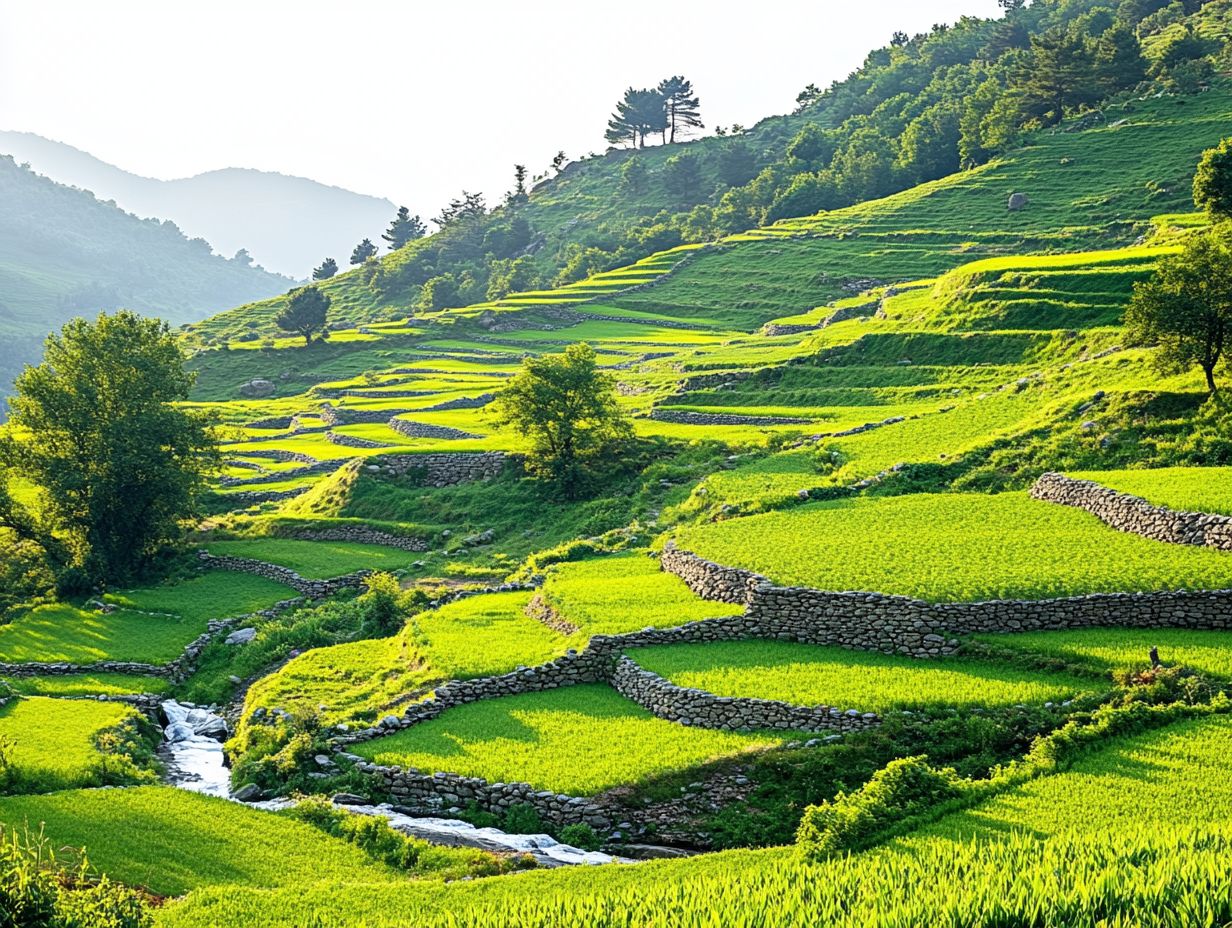
The 5 strategies to prevent soil erosion are: implementing conservation tillage, planting cover crops, building terraces, creating windbreaks, and establishing buffer strips. Additionally, you can explore 5 ways to reduce soil pollution to further enhance soil health.
How does conservation tillage help prevent soil erosion?
Conservation tillage is a method where farmers leave some crops on the ground to protect the soil from wind and water erosion. This practice also helps improve soil health and fertility.
Why are cover crops effective in preventing soil erosion and promoting soil health?
Cover crops protect the soil from erosion by keeping it covered and anchored to the ground. They improve soil structure, reduce compaction, and increase organic matter, all of which help prevent erosion.
What role do terraces and retaining walls play in preventing soil erosion?
Terraces are earth embankments built across slopes that slow down the flow of water, preventing it from eroding the soil. They are particularly effective on steep slopes and commonly used in agricultural fields.
How can windbreaks and vegetation cover help prevent soil erosion?
Windbreaks are rows of trees and shrubs planted along the edges of fields or exposed areas. They dramatically reduce wind speed, keeping your soil safe and secure!
Why are buffer strips and riparian buffers important in preventing soil erosion?
Buffer strips are areas of vegetation, such as grass or trees, planted along streams, rivers, or shorelines. They absorb excess water, trap sediment, and prevent pollutants from entering the water, thus protecting the soil from erosion.

